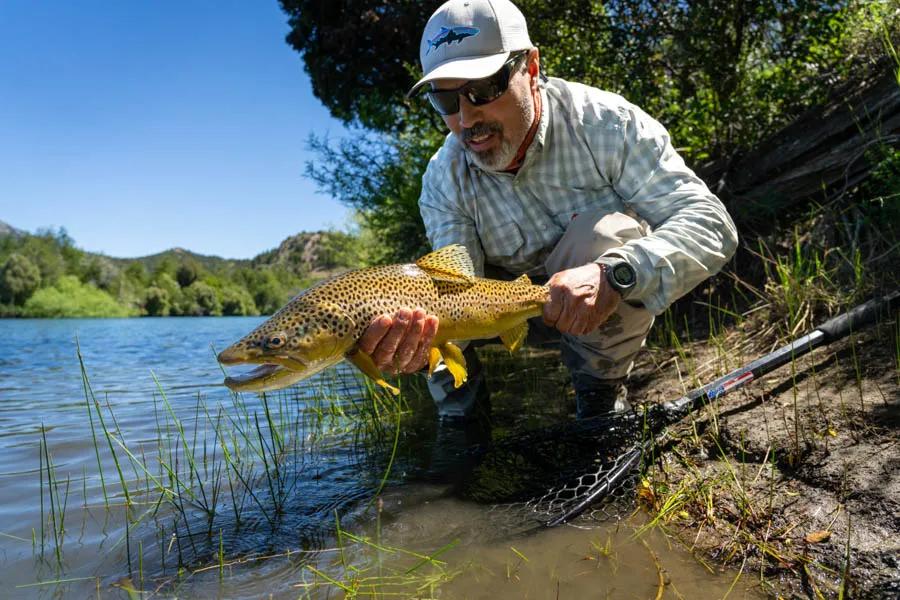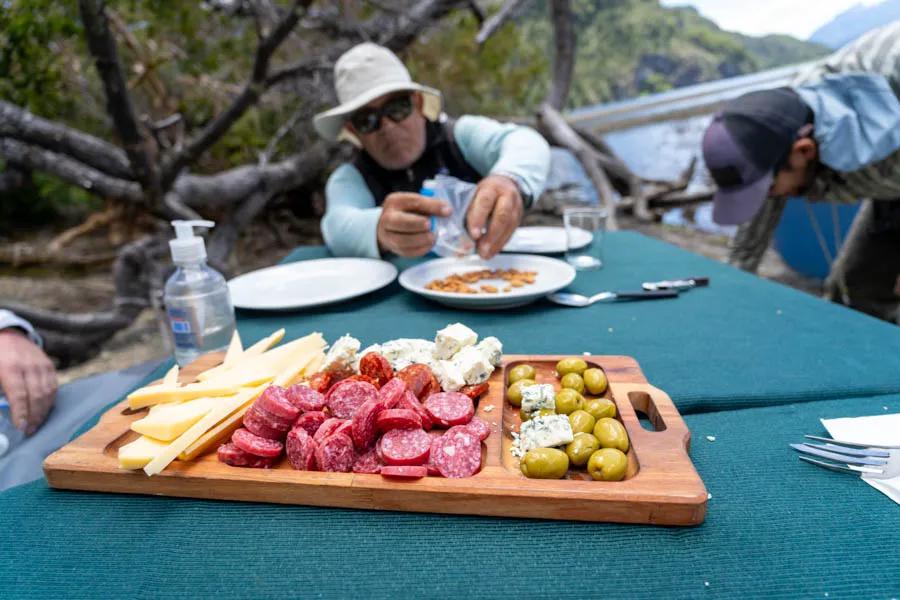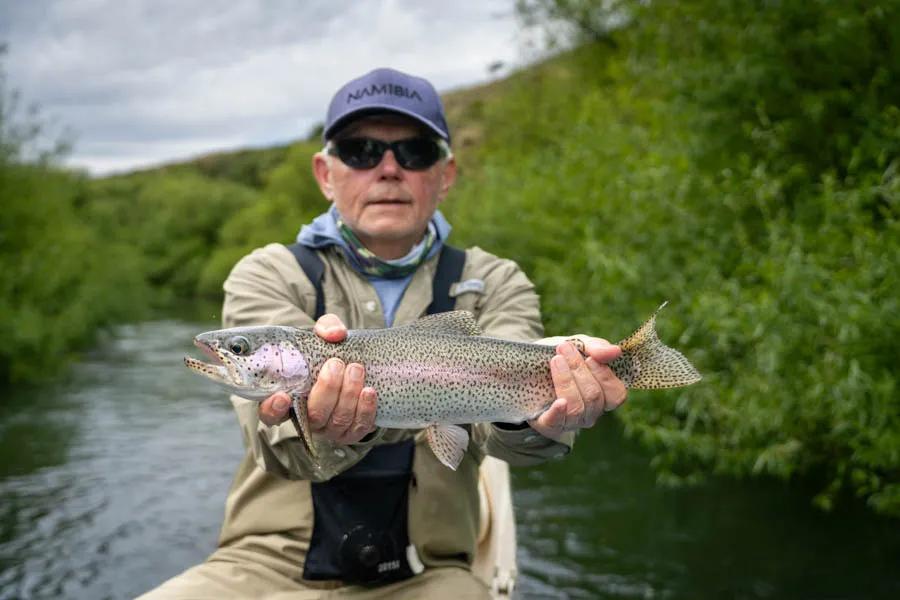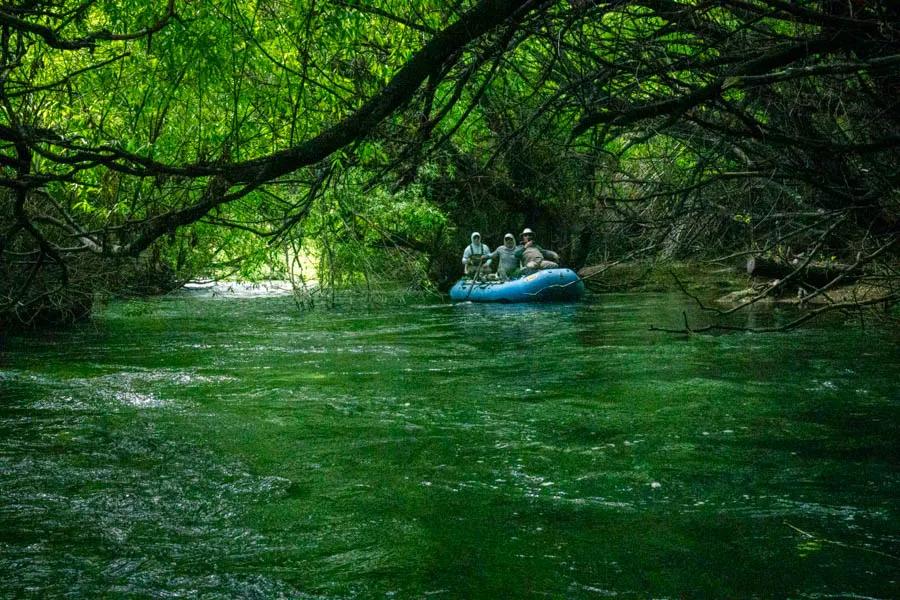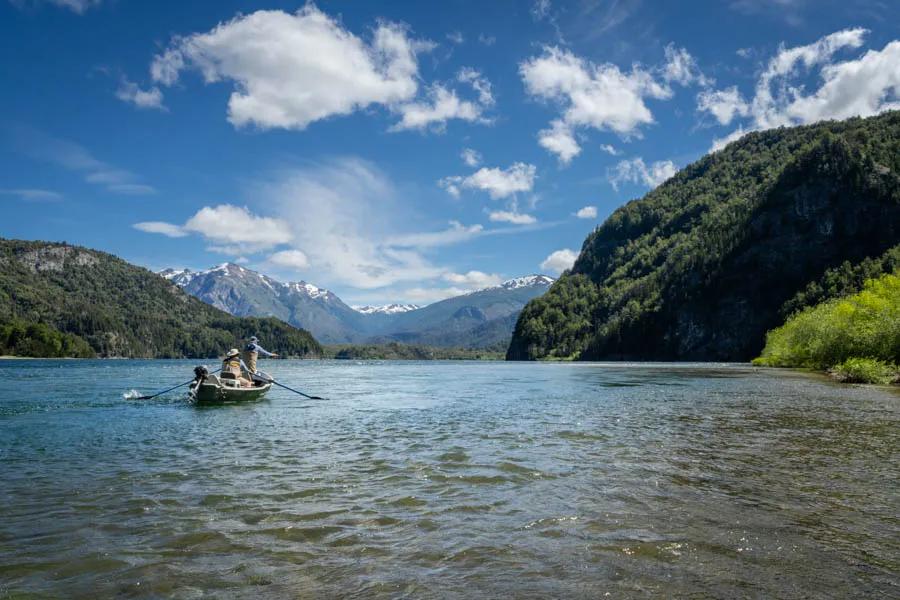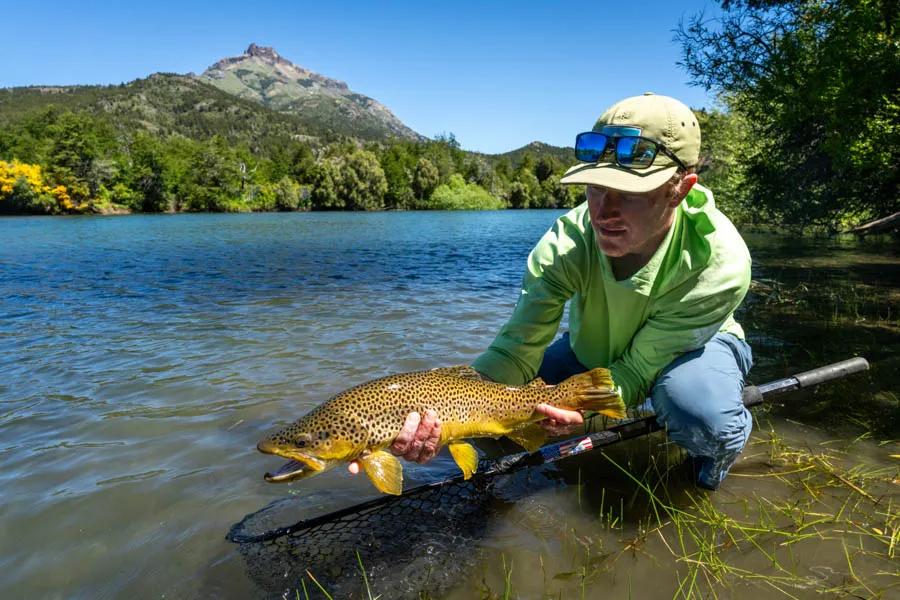
The foam Chubby Chernobyl fly was so chewed up that I had to change it, and I asked the guide if I should try something else. “It doesn’t matter,” he said nonchalantly, sitting in the middle of the raft. Sure enough, a couple of casts later another rainbow trout swam up out of the willows and gobbled up the new pattern I tried. I lost track of how many fish I had caught well before lunch that day. It took a long time to get down the Rio Chubut like that, and we were almost late for dinner.
Eager fish, Caribbean clear water, sun, snow capped peaks, and asados: Patagonia in December is a North American trout fisherman’s winter dream. The week I spent at the Carrileufu River Lodge is a delectable memory of sun and plentiful trout. What a week it was and I’m already eager to return on another hosted fly fishing trip to this spectacular part of the world.
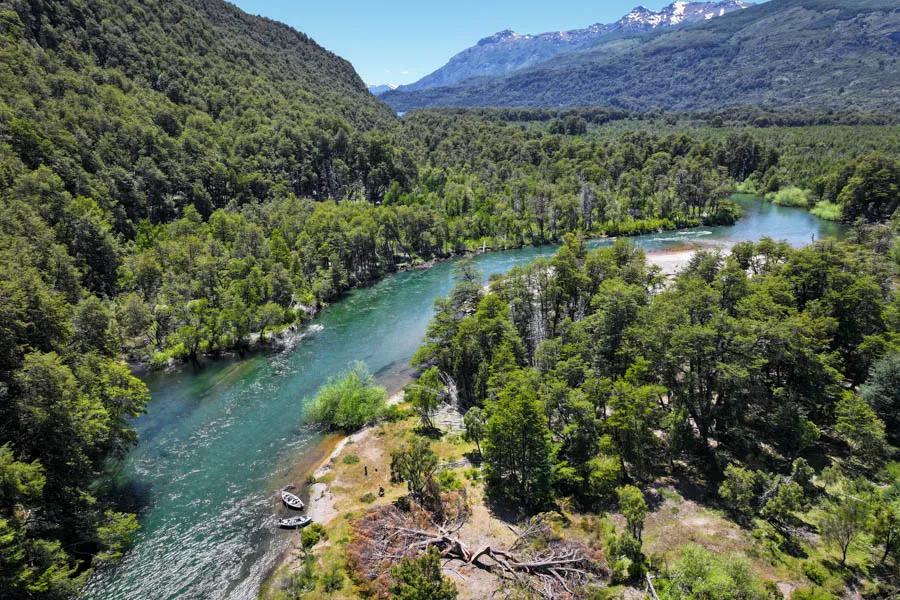
At the edge of the jagged mountains of Argentina's Alerce National Park lies Carrileufu River Lodge. The owner, Pancho, has created an iconic fishing program on par with some of the world’s most best. The lodge sits near Lago Cholila, which drains a series of short rivers connecting several lakes, each of which have their own name. Lago Cholila forms the Rio Carrileufu, which empties into Lago Rivadavia, which forms the Rio Rivadavia, which ends in Lago Verde, which feeds the Rio Arrayanes, which finally empties in Lago Futalaufquen.
The Rio Chubut is in a different drainage to the east that flows into the Atlantic Ocean, as opposed to the Pacific like many of the waters in this region. These are all beautiful, and fishy, pieces of water. Over the course of our weeklong trip we fished a variety of water and caught countless fish on another successful hosted trip.
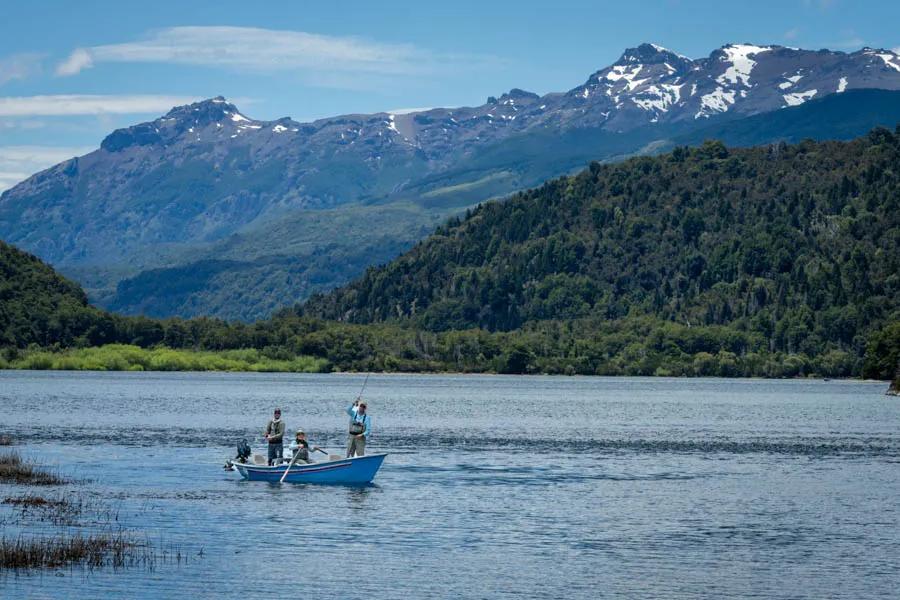
Day One: Rio Rivadavia
After a relaxing arrival night at the lodge and delicious dinner, our first day of fishing had us on the majestic Rio Rivadavia and the mouth of Lago Rivadavia. Our guide for this first day was longtime veteran lodge guide “Negro.” After about a 40 minute drive into the heart of Alerce National Park, Negro launched our boat into Lago Rivadavia–the source of the river. Negro had customized his boat with an outboard motor, and we quickly ran down the lake to the mouth of the river. Motorized boats aren’t allowed in the rivers inside Alerce National Park, but floating and fishing is allowed. Once in Rio Rivadavia, we quickly spotted a pod of rising fish in a small eddy along the right bank. In the front of the boat, Thomas picked off a couple of rainbows with a small mayfly emerger. It was clear the guides here are every bit as good as our Montana fly fishing guides back home.
We moved down a little ways to a run where Negro had us stop and wade fish for a bit. I quickly hooked a couple of small rainbows on a Frenchie nymph under a Chubby Chernobyl, and was glad I bothered setting up a dry-dropper rig. Tom had some chances on the other side of the river with the same set up, and hooked into one nice brown that jumped and threw the hook. Even though Negro said the river was actually slightly off-color, we could still spot the river’s large fish several feet deep and we spent the bulk of the day sight-fishing to trout in the crystal clear water,
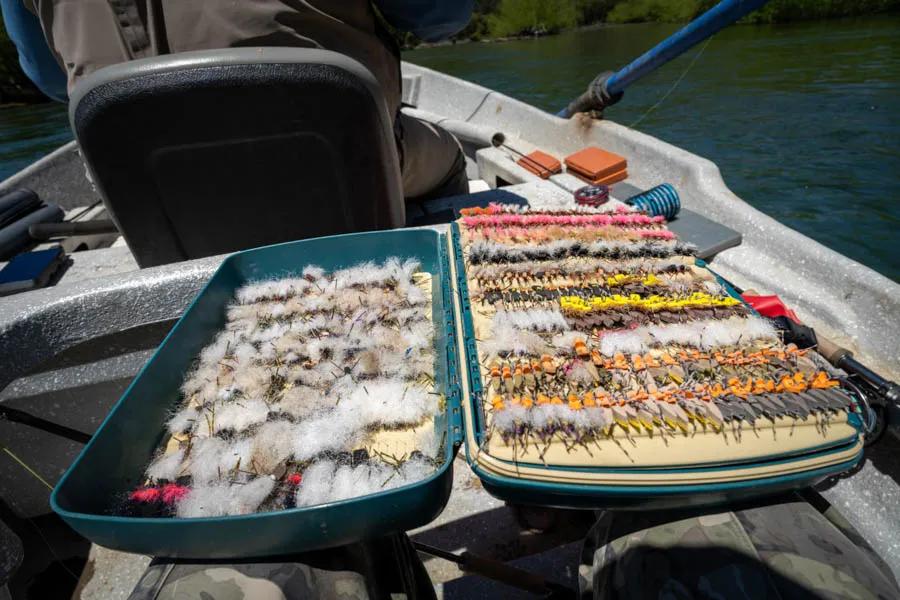
The fish were often visible in shallow flats and glides, but they were also in the juicy, deep-water logjams and classic dark, shadowy bank lies where we couldn’t see them. On the move, we would fish a Chubby Chernobly, usually with a Frenchie dropper, and casting to tasty lie after tasty lie. When Negro spotted actively rising fish, he would anchor up and we would change to a small Parachute Adams or other mayfly pattern. A good caddis hatch came off early in the day, but the actively rising fish were only interested in the mayflies that were intermittently fluttering around. Most of the fish we caught were feisty and acrobatic 15-18” rainbows, but a few times we connected with larger browns. Towards the end of the day we landed a 19-inch brown that Negro had spotted feeding on mayflies in a small eddy along the bank.
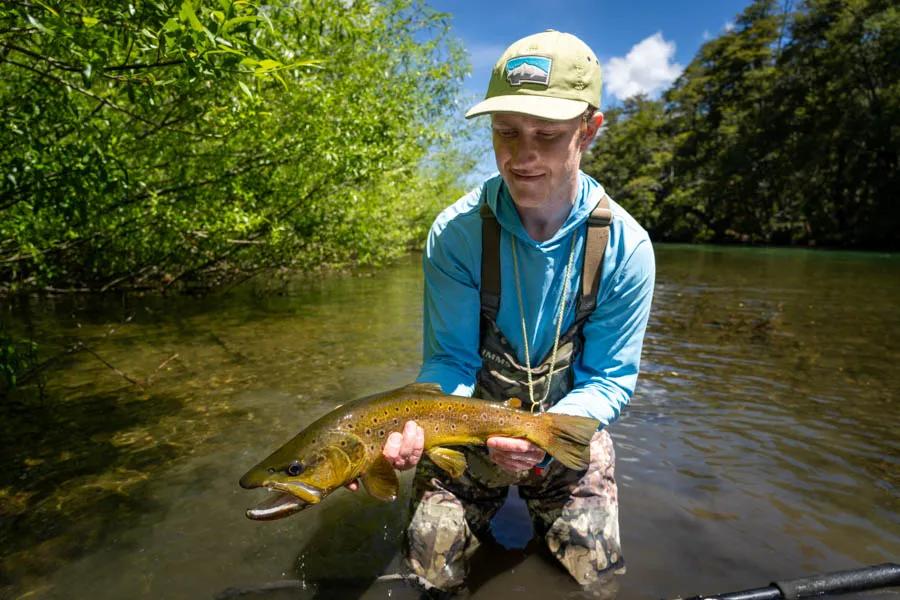
Drifting out of Rio Rivadavia into Lago Verde, we were met by a heavy breeze but Negro worked hard to keep the boat in position. Luckily, the wind calmed slightly and we floated out onto the lake, hopeful we would find opportunistic trout feeding on dragonflies. Negro tied on some ridiculous foam dragonfly pattern, and told us to cast into the weed beds where the Rivadavia flows into the lake. Before long a fat rainbow trout startled me, jumping clear out of the water as it wolfed down the fly on my second cast. We only got a few more takes on our way across the lake back to the ramp, our guide insisting on rowing hard against the wind instead of using his motor in hopes of finding more fish, but it was a fun introduction to the highlight of lake fishing in the area.
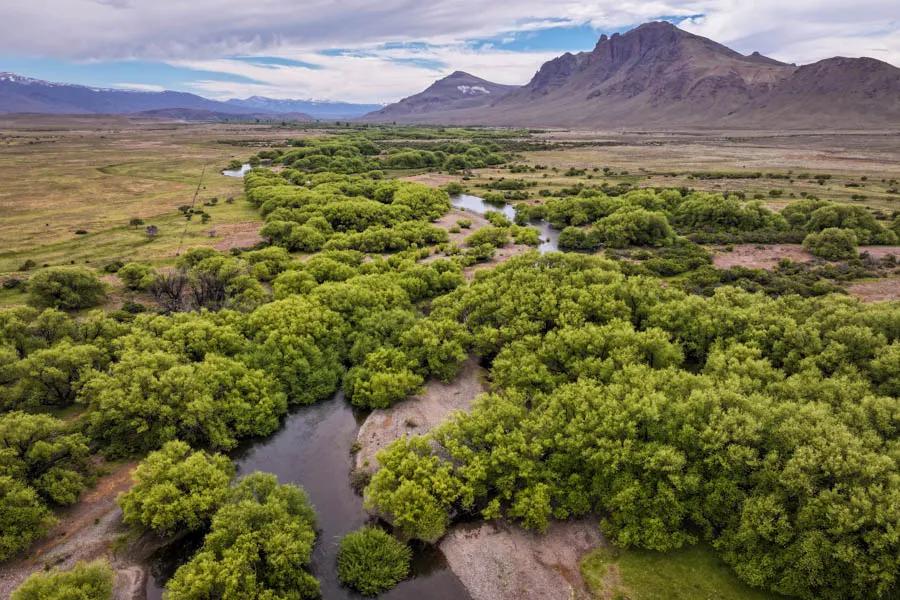
Days Two and Three: Rio Chubut Camping Trip
The fishing around Carrileufu caters to anglers who want diversity. With a variety of rivers, small creeks, and lakes, fly fishing here truly features something for everyone. The lodge itself is the ideal complement to the area’s fishing. Some of our group wanted a backcountry fly fishing experience, and Pancho, the lodge owner, has created one of the region’s more unique overnight fishing and camping trips.
Along with three other adventurous anglers, I spent two days fishing and camping on the Rio Chubut - a trip much like our overnight camping and fishing trips here in Montana. The Rio Chubut flows more than 500 miles south through Argentina and eventually into the Atlantic Ocean. Near the lodge, the Chubut meanders through a broad, arid valley. The river here is a willow lined oasis home to an astonishing amount of trout. Shortly before our two-day fly fishing adventure, a crew from the lodge floated down in a raft with machetes and chainsaws to clear a passage through the thick, mangrove-like willows. Nobody had been able to float this stretch in years, the guides said, and you could tell they were excited to fish it. Anticipation was high to fish for trout that haven’t seen flies in years.
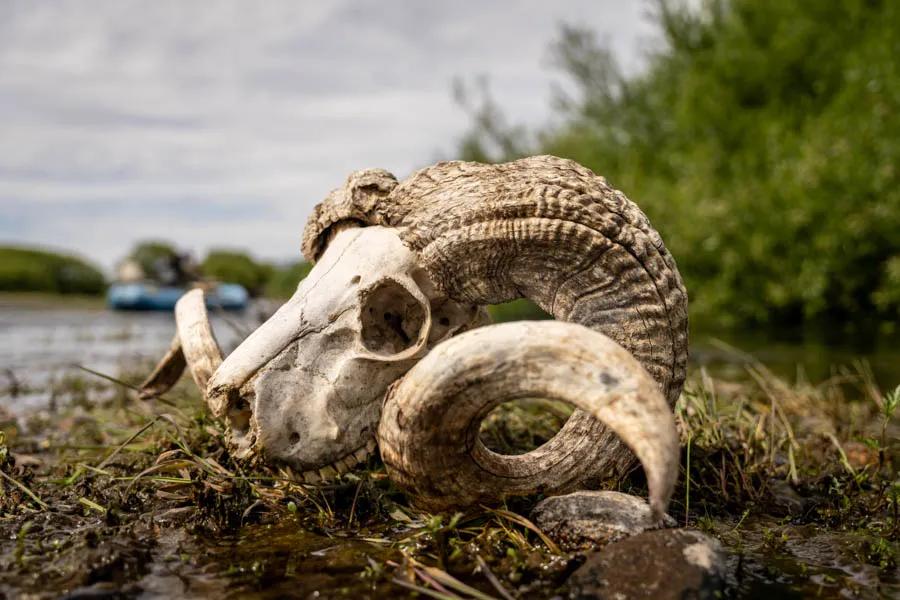
We were guided by Teo, who has been fishing the Rio Chubut since he was four years old. At the put-it, after a quick tire change due to a blowout on the highway, we were warned that there would be tight spots where we would have to duck and weave out of the way of branches, and that we would have to reel up and put the rods away in some super tight spots. It was even more overgrown than Teo or the other guide, Facu, had ever seen it, and I was incredulous that they were able to stuff the rafts down some of the willow choked tunnels cut by the lodge crew. The camp crew in their heavy raft had somehow made it down ahead of us after what must have been some tight squeezes.
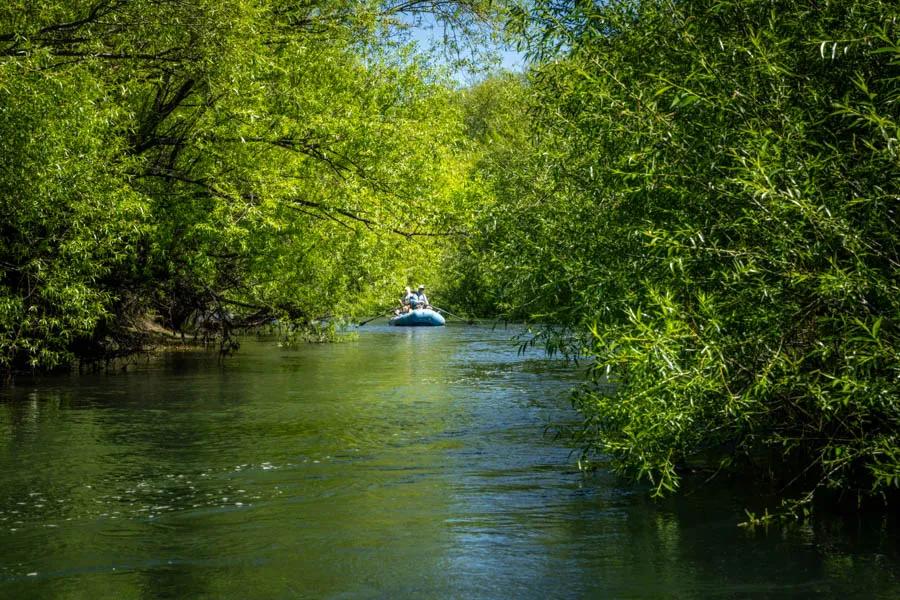
Where the river opened up in places, Teo would have us casting our flies as close to the banks and as far into the willows as possible, egging us on to try impossible seeming shots into tiny, protected open areas. “Closer,” he would say again and again. The river flowed beneath the choking, mangrove-like willows far beyond the small open channel that was floatable in many places, pouring through the dark dense willow forest in small, unnavigable channels that might never be explored, except by fish. As we would clear a tight willow tunnel and the river would open up, we would immediately cast towards the newly open banks, suddenly 20’-30’ away from our barely boat-wide channel.
A few different hatches came off while we fished the Chubut, mostly medium sized, drab colored tan and greyish mayflies, which the fish seemed to love. We also fished small Chubby Chernoblys periodically, and where the willows receded and the river opened up, Teo would have us cast the bigger dries as close to the high cut banks and other structure as possible. A short 4-weight would be a great rod for the Chubut. Bright sun and tight casting made for some unique situations the first day, but it was a great preview for the excitement to come.
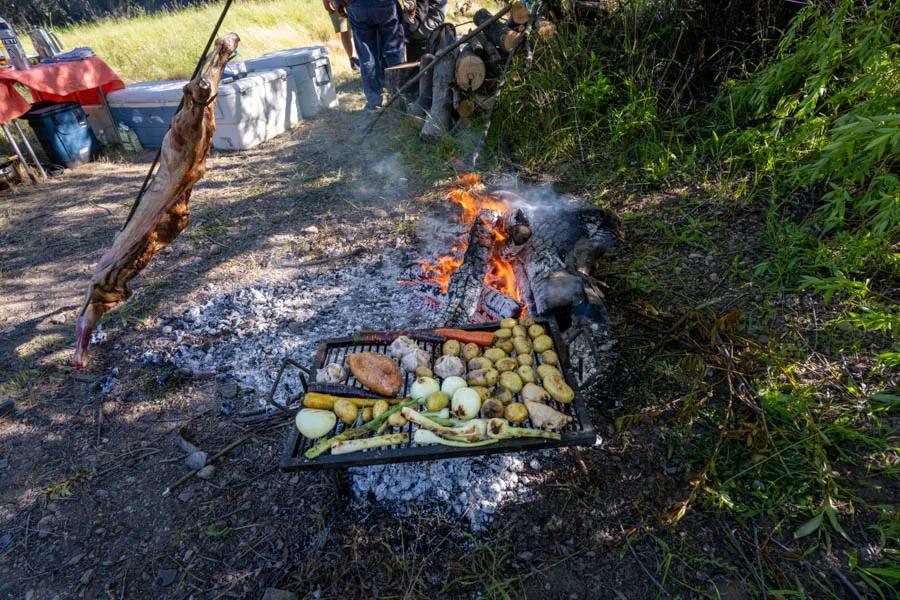
The camp crew, Aldo and Facu, had floated down ahead of us with all of the provisions and camp gear. They had a luxurious camp set up when we floated in around six o’clock, complete with a lamb roasting asada style along the riverbank. Cabela's Outfitter tents and cots were set up, the same as Montana Angler uses on our Smith River and overnight camping trips. A covered dining tent and outdoor bar and appetizer area were set up near the fire and the roasting lamb as well. Dinner was delicious and paired tastefully with a nice red Argentine Cabernet. We enjoyed some sunset fishing in front of camp, where we could see rising trout river-wide. We talked by the fire for a while as we admired the stars before we turned in.
We woke to overcast skies and cool temperatures. Up early, I stoked the coals of the fire as others rose. We gradually congregated around the flames, drinking coffee and eating eggs and toast that Facu made for us.
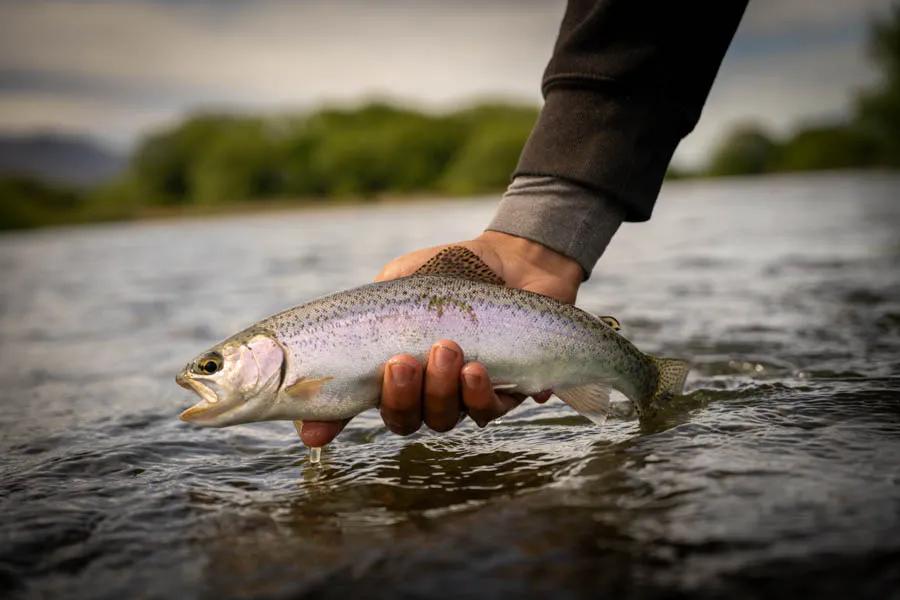
The river ahead looked promisingly open, and almost immediately after leaving camp I landed a rainbow on a small Parachute Adams. Soon after, my boat companion, Tom, had a couple of fish take his small foam dry fly. Sensing fish were on the hunt, Teo, our guide, put a big, red mohair leech on my rod, and told me to strip it fast. Within a few casts we saw a fish chase the fly, then shortly after I landed a nice rainbow on it. Teo put a small dropper nymph below Tom’s Chubby Chernobyl, and he was quickly into fish on it and the dry fly up in front of the boat. Fish kept chasing my streamer for another hour or so, then seemed to lose interest, so Teo rigged a dry dropper rig for me too.
We fished that way the rest of the morning and did great, then stopped on a gravel bar on the inside of a deep, sharp bend in the river for lunch. A few of us did some more fishing while Facu fried up some delicious hamburgers for us, complete with bacon and caramelized onions. The rest of the afternoon, Tom and I caught countless fish on Chubby Chernobyls and small droppers. The other guys in Facu’s boat mostly fished a yarn indicator rig with one large and one small nymph, and they caught loads of fish as well. Most of the trout were medium sized rainbows, but we did catch and see a few browns, including one good sized fish that ate a Chubby Chernobyl but broke off in the ensuing fight. Teo kept telling us he has seen the occasional giant brown hooked in this river. We hustled getting the rafts loaded onto the trailers at the take out and rode back to the lodge in our waders, running a little late for dinner after having stayed out late catching so many fish.
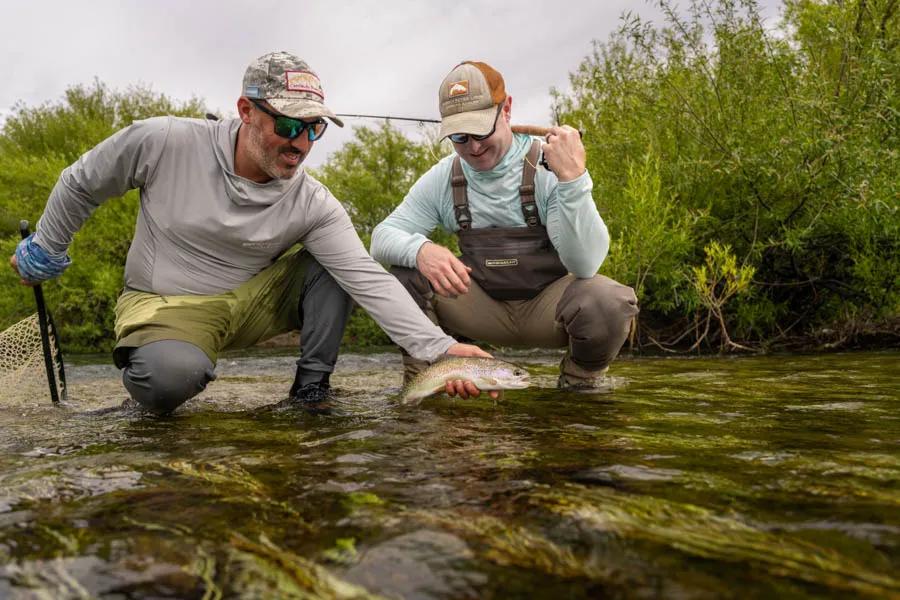
Day Four: Spring Creek Day
After camping on the Rio Chubut, our guide the next day, Facu, decided to take us to a small spring creek in the area for a few hours. We were excited to see how a spring creek in Patagonia compares to our spring creeks here in Paradise Valley. It looked unassuming, but there were large brook trout, rainbows, and browns swimming around in the translucent greenish clear water. The fishing was very tricky - the water was clear, the fish were spooky, there was almost no current, and overhanging trees snagged our backcasts. Despite the difficulties, we managed to hook a big brown trout and landed a nice brookie tightlining small nymphs. It was a beautiful little creek, and a nice change of pace from the mostly float fishing we had done the previous few days. The spring creek day was a special day of sight-fishing and allowed us to hone some of our casting and fishing skills.
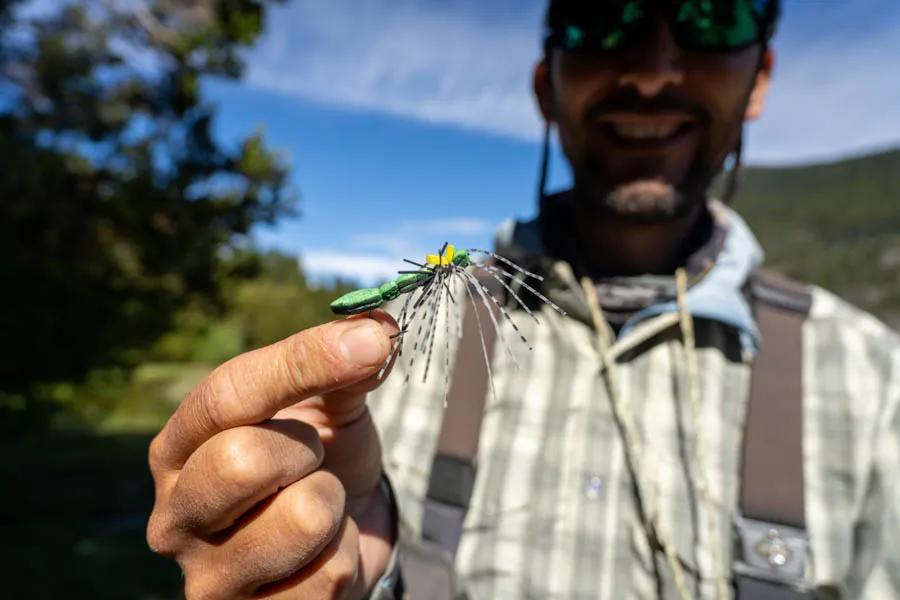
Day Five: Rio Arrayanes
Next was the Rio Arrayanes, a beautifully clear section of river connecting Lago Verde and Lago Futalaufquen. The guides, German and Juancho, started the day with us fishing Lago Verde with big floating dragonfly patterns. They said it was still a little early in the season for the bulk of the hatch, but we found quite a few good sized fish by twitching and drifting the gaudy dragonfly patterns along the cliff banks and weed beds. Fish would often jump clear out of the water with reckless abandon if they decided to eat, like they were chasing a real dragonfly buzzing erratically above the surface. While fighting a 17” or so rainbow that had taken the dragonfly, a giant brown trout appeared out of nowhere and chased the fish for several seconds, then vanished. After a couple of hours the wind kicked up, so we ate an early lunch and then let the gentle current pull us into the Rio Arrayanes. We had changed to a 250 grain sinking line and rigged up a streamer for the second part of our day.
After casting as far as possible out into the deep, slow moving water where the river began, we would let the Sparkle Minnow sink for 15+ seconds, then quickly retrieve it with long, accelerating strips. We brought a few fish to hand right after lunch that way, then slowly drifted into the main part of the river. Further into the Rio Arrayanes where the water wasn’t as deep, my guide, German, had me cast the streamer as far and tight to the bank and fallen log jams as possible, then strip it back immediately, nearly as fast as I could. We noticed some fish chasing when I moved the fly very aggressively to keep it out of sunken logs by sweeping the rod tip, and it seemed that the faster the retrieve was, the more the fish liked it. Throughout the afternoon we saw lots of fish chase the fly in the clear, blue water, creating the feeling that each next cast could be the one that turned a giant. By the time we reached the end of the river, we had landed several nice trout, mostly rainbows. We also missed several fish that struck too quickly to set the hook while frantically moving the flies as fast as we could. The magic was watching it all unfold in the crystal clear water.
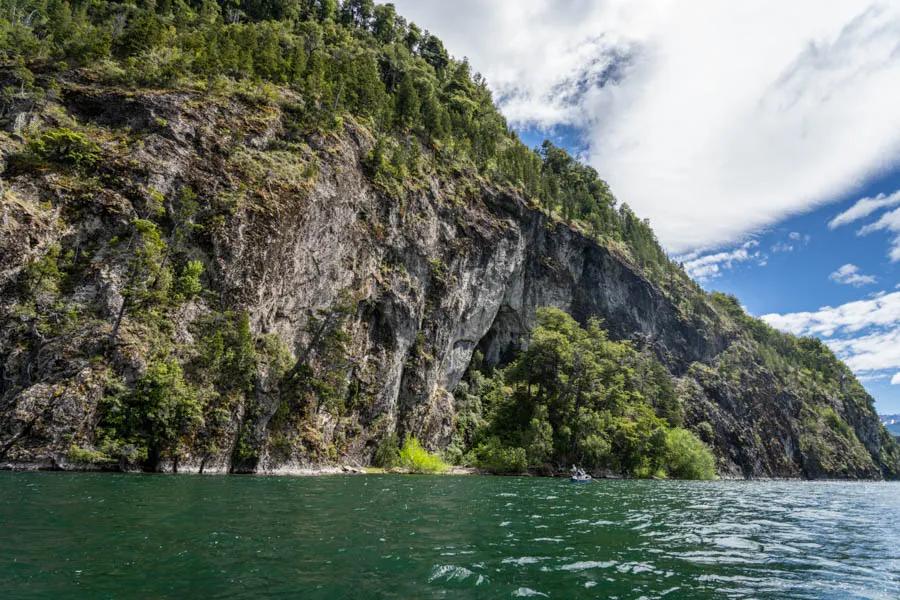
While fishing, we passed one pretty looking tributary, Rio Menendez, that German told me is protected from any sort of recreational use, though he said a few of the guides had fished it years ago before the regulations were put in place. He changed streamers a few times throughout the day, but we did best using a large Sparkle Minnow and an articulated Kreelex pattern that someone told me to tie for the trip. Along the float we saw a few fish rise and tried throwing the dragonfly dry, but we didn’t have any takes. Once we eventually floated into Lago Futalaufquen, the other guide, Juancho, hooked his anchor rope to our boat and used his outboard motor to pull us all the short distance to the take out area on the beach. We returned to the lodge in a little over an hour after a scenic drive in German’s Toyota Hilux.
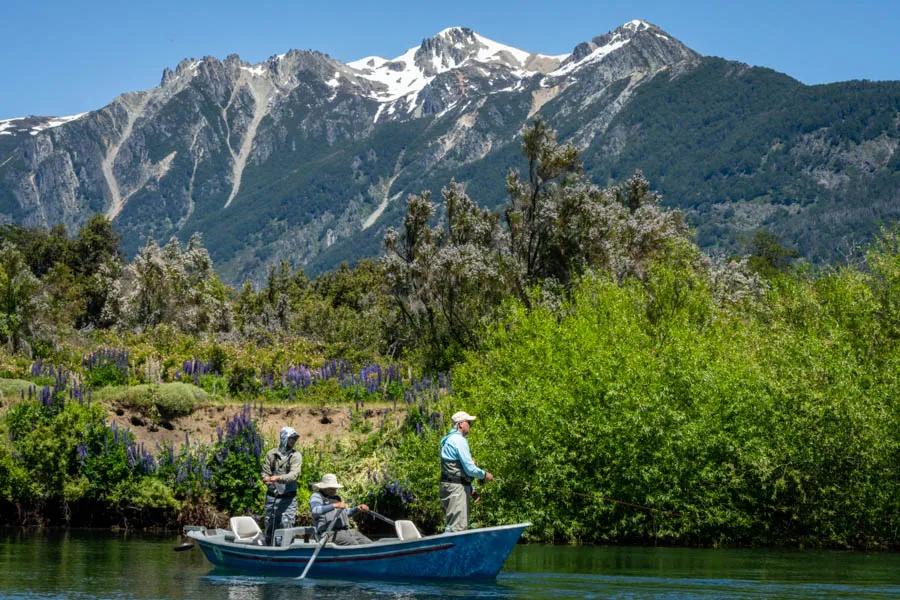
Day Six: Rio Carrileufu
The last day, I fished the lodge’s namesake Rio Carrileufu with guide Pablo in his custom painted Ro Deville. A quick 10 minute drive from the lodge had us at the start of the lower section of Rio Carrileufu. We would float the last 7 or 8 kilometers of the river and end in the lake, Lago Rivadavia. Pablo set up my 7 weight with a 250 grain sinking line and tied on a swanky looking custom green and olive Wooly Bugger. I quickly caught several nice rainbow trout by moving the fly with short strips through deep runs and bank lies as Pablo suggested. We changed flies a few times in the morning before settling on a similar looking, but mostly black colored fly. Fish were appearing to chase and flash from seemingly everywhere, sometimes on consecutive casts. We were blind casting to promising looking spots, but the water was so clear that as soon as fish moved towards the fly you could usually spot them. We mostly targeted spots along the bank close to the overhanging willows, but sometimes fished flats and the deeper runs in the middle of the river. Most of the fish landed were rainbows, but we moved a couple of good size browns in the morning. After lunch, Pablo let me row his boat in a slow section of river for a little while and he quickly caught a few fish before we switched back.
Close to the end of our float as we neared Lago Rivadavia, the golden shape of a large brown trout suddenly appeared behind my wooly bugger from the depths beneath an overhanging willow. The fish followed the fly for a few feet, paused, then bit. I managed to set the hook, and after a brief, thrashing fight Pablo netted the fish and we exchanged excited high fives. Slowly floating the last remaining 15 minutes or so into Lago Rivadavia I made a few more casts to round out the spectacular week, but was fully content and thrilled for that large brown trout to be the last fish of my trip.
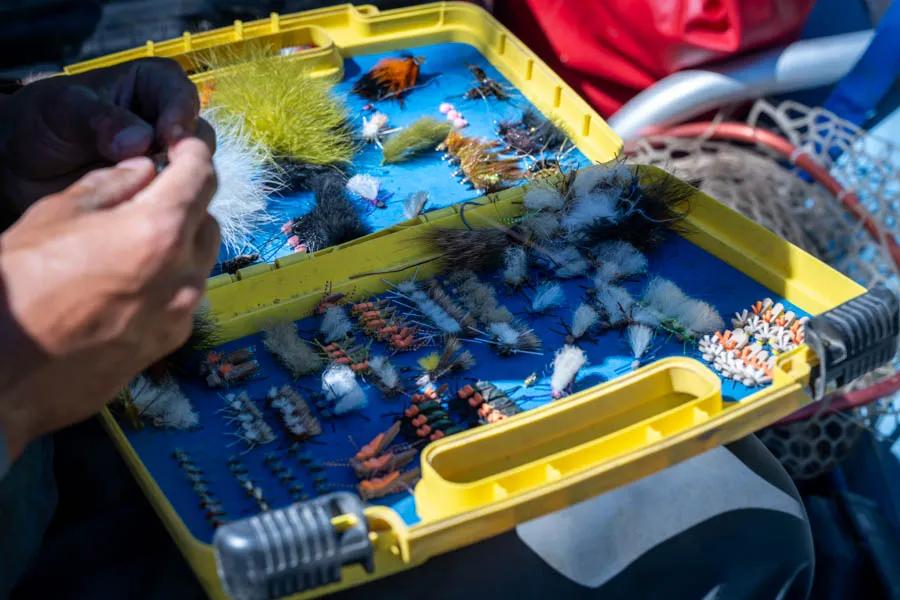
Rods, Fly Lines, and Flies
The 9’ 5 weight rod I brought got used the most and I was really happy to have packed a rod lighter than a 6 weight for fishing the tight Rio Chubut and the spring creek. I actually wish I had brought a short 4 weight rod instead for those days. The Chubut and the spring creek aren’t the most common waters for lodge guests to fish though, and for the main rivers and lakes in the area a 9' 6 weight rod is the best option for casting larger dries and droppers into the persistent wind. A streamer rod with a fast sinking 250 grain or 300 grain line was the main tool we used on the Rio Arrayanes and Rio Carrileufu, but it was still handy to have one rod rigged with a floating line and second rod rigged with a sinking line and streamer.
We fished a lot of Chubby Chernobyls in sizes 8 to 12 or so, depending on the river. We used royal, green, tan, and peacock/black colors most often with, frequently a small frenchie or other drab colored perdigon style nymph dropped below. The guides tried a few other foam dry fly patterns like Fat Alberts and Water Walkers, but Chubby Chernobyls worked best for us. When bugs were hatching, we did best with tan, grey, and royal colored mayfly patterns, particularly parachutes, in fairly small sizes around #16. There was also a pretty good hatch of light tan caddis flies around #16 or so on the Rio Rivadavia, but the trout seemed more interested in mayflies patterns than the caddis flies we tried, even during the height of the hatch. Streamers we used were small to medium size, single hook patterns. Sparkle minnows, particularly the sculpin and brown/yellow JJ colors, Kreelexes, and Wooly Bugger style patterns were all we needed. This article on the best streamers for Montana also proved helpful for fly fishing in Argentina.
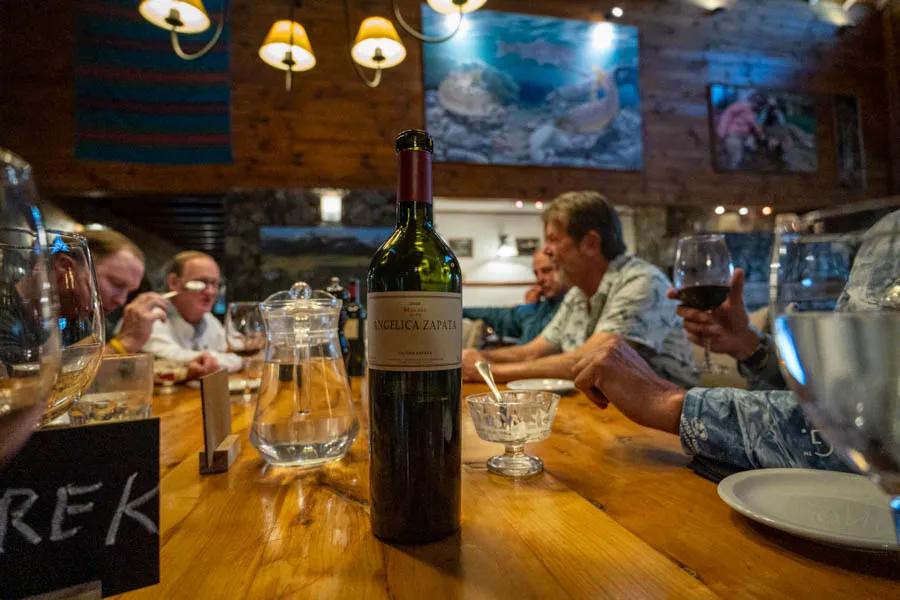
Lodge Amenities at Carrifeulu River Lodge for a Patagonia Fly Fishing Trip
The lodge has free, daily laundry service so you don’t need to pack lots of clothes.
Wall power outlets at Carrileufu River Lodge and at the Intersur Recoleta hotel in Buenos Aires are three pronged Type I outlets.
There are some loaner waders and wading boots available at the lodge, but it’s best to bring your own if possible to ensure you have the right size. Some sizes were not available.
Bringing your own rods is ideal, but the guides did have 6 weight rods with floating and sinking lines available for guests to use if needed.
Wet wading was very comfortable on sunny days, and we mostly fished out of the boat anyways, so having sandals with a strap or wading socks to wear with wading boots was a nice option.
The lodge has a sauna available for free, and holistic massages available for additional cost.
The lodge and camp trips have a full bar and great wine selection.
The staff at the lodge greeted us warmly when we arrived, offered us snacks and drinks from the fully stocked bar, and showed us to our rooms. Throughout our stay, Oliver, Franco, Facu, Aldo, Pancho, Pablo, and the rest of the lodge staff were very helpful and welcoming, and the food was fantastic at each meal. Local specialities and fresh produce were usually featured, including a beloved asado on our last night. Lunch was always an elaborate, shoreside affair paired with wine and coffee.
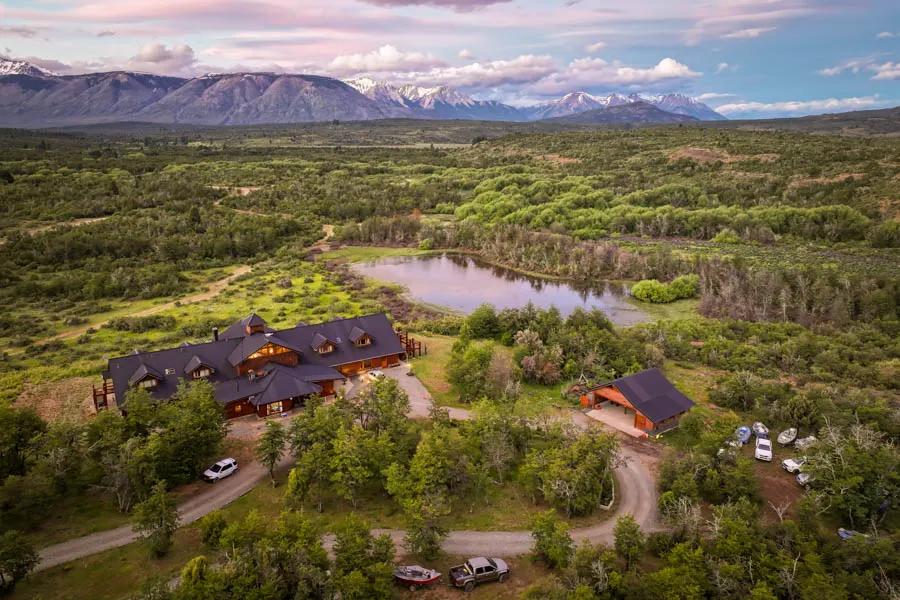
Travel Tips and Essential Info
Most fly fishing trips to Argentine Patagonia embark through Buenos Aires, often requiring your arrival night to be spent in the historic and beautiful city. Domestic flights in Argentina depart from a separate airport, Aeroparque Jorge Newberry, which requires an additional ground transfer. Upon your arrival in Buenos Aires, consider booking a transportation service ahead of time through a trusted travel agency to be sure you make your connecting flights and everything goes smoothly in the chaotic Argentine airports.
If you have time, spend an extra few days exploring Buenos Aires. In addition to touring the city or the river delta by boat, some popular local activities include attending polo and soccer matches, and watching tango performances in the birthplace of the dance.
The Intersur Recoleta hotel, where half of our group stayed, is an upscale establishment in the historic Recoleta neighborhood of Buenos Aires, close to a large historic cemetery, great restaurants, and high end shops. Around the corner and across the street from the hotel, our group met for a fine dinner at the Rufino steakhouse the evening before we travelled to the lodge. An extra day or two to see the historic city of Buenos Aires would have been nice, but I was also eager to go fishing.
Rod tubes are allowed as carry-on items on international flights to Buenos Aires. However, on your international flight from Argentina into the US you must check the rod tubes. They also must be checked on local flights going through the regional AEP airport. Reels and flies in my carry-on backpack were no issue going through security. The Pre-Trip Planning information was very helpful.
The regional airport, AEP, where our group had to catch a flight south from Buenos Aires to the small Patagonian town of Esquel, was horribly busy because of the start of the Argentinian summer break. Everyone in our group luckily made it through the long luggage check line with time for some refreshments before our flight though. The local passengers applauded when our plane touched down in Esquel, and we were met at the tiny one gate airport by German, one of the Carrileufu River Lodge guides. It was about a ninety minute drive to the lodge and the scenery kept getting prettier as we crossed the flatlands and approached the mountains. Purple and pink lupin flowers were in full bloom and underscored the gorgeous views of the snow capped peaks of Los Alerces National Park as we neared the little town of Cholila, a few minutes from the lodge.
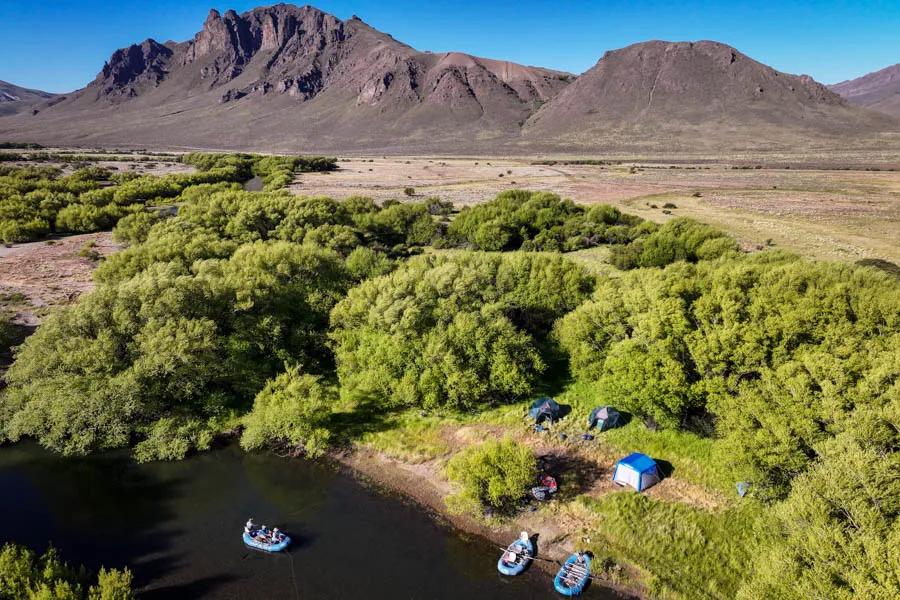
By the end of the week, our group had fished a variety of beautiful waters and had caught a bunch of fish. I couldn't pick a single favorite river, and I wish I had more time to fish them all. It was a warm week spent with great fishing, company, and food, and now, back halfway around the world in snowy Montana, I can’t help but think of returning. I know I’ve only scratched the surface of fishing in Patagonia.
